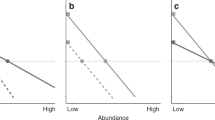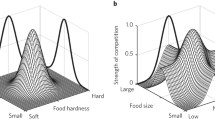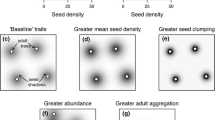Abstract
Understanding the factors that govern the commonness and rarity of individual species is a central challenge in community ecology. Empirical studies have often found that abundance is related to traits associated with competitive ability and suitability to the local environment and, more recently, also to negative conspecific density dependence. Here, we construct a theoretical framework to show how a species’ abundance is, in general, expected to be dependent on its per-capita growth rate when rare and the rate at which its growth rate declines with increasing abundance (strength of stabilization). We argue that per-capita growth rate when rare can be interpreted as competitive ability and that strength of stabilization largely reflects negative conspecific inhibition. We then analyze a simple spatially implicit model in which each species is defined by three parameters that affect its juvenile survival: its generalized competitive effect on others, its generalized response to competition, and an additional negative effect on conspecifics. This model facilitates the stable coexistence of an arbitrarily large number of species and qualitatively reproduces empirical relationships between abundance, competitive ability, and negative conspecific density dependence. Our results provide theoretical support for the combined roles of competitive ability and negative density dependence in the determination of species abundances in real ecosystems, and suggest new avenues of research for understanding abundance in models and in real communities.






Similar content being viewed by others
References
Adler FR, Muller-Landau HC (2005) When do localized natural enemies increase species richness? Ecol Lett 8(4):438–447. doi:10.1111/j.1461-0248.2005.00741.x
Adler PB, HilleRisLambers J, Kyriakidis PC, Guan QF, Levine JM (2006) Climate variability has a stabilizing effect on the coexistence of prairie grasses. Proc Natl Acad Sci USA 103(34):12793–12798. doi:10.1073/pnas.0600599103
Adler PB, Hille Ris Lambers J, Levine JM (2007) A niche for neutrality. Ecol Lett 10(2):95–104
Adler PB, Ellner SP, Levine JM (2010) Coexistence of perennial plants: an embarrassment of niches. Ecol Lett 13(8):1019–1029. doi:10.1111/j.1461-0248.2010.01496.x
Amarasekare P (2009) Competition and coexistence in animal communities. In: Levin SA (ed) The Princeton Guide to Ecology. Princeton University Press, Princeton, pp 196–201
Armstrong RA (1989) Competition, seed predation, and species coexistence. J Theor Biol 141(2):191–195
Bell T, Freckleton RP, Lewis OT (2006) Plant pathogens drive density-dependent seedling mortality in a tropical tree. Ecol Lett 9(5):569–574. doi:10.1111/j.1461-0248.2006.00905.x
Carson WP (2008) Challenges associated with testing and falsifying the Janzen-Connell hypothesis: a review and critique. In: Carson WP, Schnitzer SA (eds) Tropical Forest Community Ecology. Wiley-Blackwell, Oxford, pp 210–241
Chave J, Muller-Landau HC, Levin SA (2002) Comparing classical community models: theoretical consequences for patterns of diversity. Am Nat 159(1):1–23
Chesson P (2000) Mechanisms of maintenance of species diversity. Annu Rev Ecol Syst 31:343–366
Chisholm RA, Pacala SW (2010) Niche and neutral models predict asymptotically equivalent species abundance distributions in high-diversity ecological communities. Proc Natl Acad Sci USA 107(36):15821–15825
Comita LS, Muller-Landau HC, Aguilar S, Hubbell SP (2010) Asymmetric density dependence shapes species abundances in a tropical tree community. Science 329(5989):330–332. doi:10.1126/science.1190772
Fargione J, Tilman D (2006) Plant species traits and capacity for resource reduction predict yield and abundance under competition in nitrogen-limited grassland. Funct Ecol 20(3):533–540. doi:10.1111/j.1365-2435.2006.01116.x
Grover JP (1990) Resource competition in a variable environment: phytoplankton growing according to Monod's model. Am Nat 136(6):771–789
Hubbell SP (2001) The unified neutral theory of biodiversity and biogeography. Princeton University Press, Princeton
Klironomos JN (2002) Feedback with soil biota contributes to plant rarity and invasiveness in communities. Nature 417(6884):67–70
Levin SA (1970) Community equilibria and stability, and an extension of competitive exclusion principle. Am Nat 104(939):413–423
Levin SA (2000) Multiple scales and the maintenance of biodiversity. Ecosystems 3(6):498–506
Levine JM, HilleRisLambers J (2009) The importance of niches for the maintenance of species diversity. Nature 461(7261):254–U130. doi:10.1038/nature08251
Mamolos AP, Veresoglou DS, Barbayiannis N (1995) Plant species abundance and tissue concentrations of limiting nutrients in low-nutrient grasslands: a test of competition theory. J Ecol 83(3):485–495
Mangan SA, Schnitzer SA, Herre EA, Mack KML, Valencia MC, Sanchez EI, Bever JD (2010) Negative plant-soil feedback predicts tree-species relative abundance in a tropical forest. Nature 466(7307):752–U710. doi:10.1038/nature09273
McGill BJ (2003) A test of the unified neutral theory of biodiversity. Nature 422:881–885
Muller-Landau HC (2010) The tolerance-fecundity trade-off and the maintenance of diversity in seed size. Proc Natl Acad Sci USA 107(9):4242–4247. doi:10.1073/pnas.0911637107
Muller-Landau HC, Adler FR (2007) How seed dispersal affects interactions with specialized natural enemies and their contribution to diversity maintenance. In: Dennis AJ, Schupp EW, Green RJ, Westcott DW (eds) Seed dispersal: theory and its application in a changing world. CAB International, Wallingford, pp 407–426
Pennisi E (2005) What determines species diversity? Science 309(5731):90. doi:10.1126/science.309.5731.90
Rees M, Westoby M (1997) Game-theoretical evolution of seed mass in multi-species ecological models. Oikos 78:116–126
Theodose TA, Jaeger CH, Bowman WD, Schardt JC (1996) Uptake and allocation of 15N in alpine plants: implications for the importance of competitive ability in predicting community structure in a stressful environment. Oikos 75(1):59–66
Tilman D (1990) Constraints and tradeoffs: toward a predictive theory of competition and succession. Oikos 58(1):3–15
Tilman D (1994) Competition and biodiversity in spatially structured habitats. Ecology 75(1):2–16
Tilman D, Kilham SS, Kilham P (1982) Phytoplankton community ecology: the role of limiting nutrients. Annu Rev Ecol Syst 13:349–372
Tsialtas JT, Handley LL, Kassioumi MT, Veresoglou DS, Gagianas AA (2001) Interspecific variation in potential water-use efficiency and its relation to plant species abundance in a water-limited grassland. Funct Ecol 15(5):605–614
Volkov I, Banavar JR, He FL, Hubbell SP, Maritan A (2005) Density dependence explains tree species abundance and diversity in tropical forests. Nature 438(7068):658–661
Volkov I, Banavar JR, Hubbell SP, Maritan A (2007) Patterns of relative species abundance in rainforests and coral reefs. Nature 450(7166):45
Acknowledgments
We thank Marco Visser for helpful comments on the manuscript. We thank Simon Levin and David Earn for advice on the stability analysis. We gratefully acknowledge the financial support of the Smithsonian Institution Global Earth Observatories (SIGEO) and the HSBC Climate Partnership.
Author information
Authors and Affiliations
Corresponding author
Appendices
Appendix I: Coexistence in the absence of negative density dependence
We investigate coexistence in our model in the absence of negative density dependence (i.e., η i = 0). In this case, the master equation becomes:
It can be seen from this equation that β i represents intrinsic fitness because it measures differences in relative growth rates in the absence of stabilizing forces (Chesson 2000). To solve for equilibrium, we let \( {p_{{i,t + 1}}} = {p_{{i,t}}} = {\overline p_i} \). Assuming that \( {\overline p_i} \ne 0 \), we have:
which means that every species that persists at equilibrium must have an identical value of β i . The master equation then degenerates to:
meaning that species will persist at their initial abundances. This model is clearly only neutrally stable.
Appendix II: Mathematical details from equilibrium abundances section
We want to show that \( g\left( {\overline {{\bf p}} } \right) \) declines monotonically with the addition of more (stably coexisting) species to the system defined by (2). Start with a system of n (stably coexisting) species with equilibrium relative abundances \( {\overline {{\bf p}}_n} \), so that:
Now add another (stably coexisting) species to the system so that there are n + 1 species and:
We know from the coexistence condition (4) that:
This in turn implies that:
and thus:
where the final equality follows from
for any x.
Appendix III: Local stability analysis for the two-species case
We complete the stability analysis for the two-species case started in the main text. Let \( {\eta_i} = {\gamma_i}/{\alpha_i}{\beta_i} \). We want to show that
Note that the three factors in the denominator of m crit are positive and the parenthetic expression in the numerator is positive too because:
Now let:
So we have:
The first factor in braces here is positive because:
The second factor in the expression for A − B is negative because:
and so \( A - B > 0 \). We know that B is positive, so \( {m_{\rm{crit}}} = A/B > 1 \).
Appendix IV: Jacobian for the general case
We want to compute the Jacobian A evaluated at the equilibrium (3) of the dynamical system defined by (2). Let \( {\eta_i} = {\gamma_i}/{\alpha_i}{\beta_i} \). To do this, we require the partial derivatives of the expression on the right hand side of the master equation (2):
where
and so
and
and so
These expressions can be used to compute the partial derivatives of F i :
and
for \( i \ne j \). Note that:
for any j. Intuitively, this follows because the F i just represent all of the p i and time t + 1 and the net change in these with a change in p j is just one.
Now at, \( {{\bf p}} = \overline {{\bf p}} \), we have:
and so:
where
and:
for i ≠ j, and
We can then write a general expression for the entries of the Jacobian A:
where δ ij is the Kronecker delta. Note that \( {\beta_i}g\left( {\overline {{\bf p}} } \right) - 1 > 0 \) because this is a necessary and sufficient condition for coexistence, as discussed in the main text.
Rights and permissions
About this article
Cite this article
Chisholm, R.A., Muller-Landau, H.C. A theoretical model linking interspecific variation in density dependence to species abundances. Theor Ecol 4, 241–253 (2011). https://doi.org/10.1007/s12080-011-0119-z
Received:
Accepted:
Published:
Issue Date:
DOI: https://doi.org/10.1007/s12080-011-0119-z




